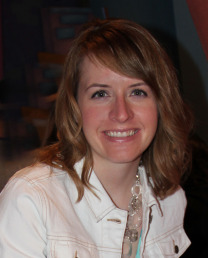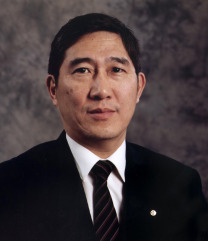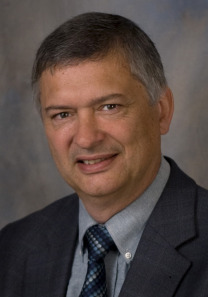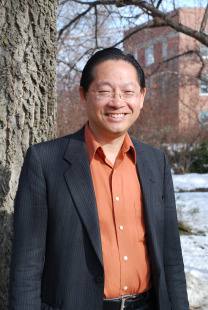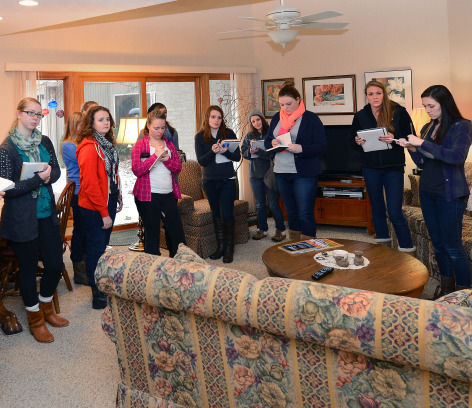
Iowa State students take notes about the elements they want to incorporate into design plans for the Northcrest expansion. Photo by Bob Elbert (Larger photo)
AMES, Iowa – Safe and affordable housing is a critical issue as people live longer and decide to “age in place” or move to a senior community. Older adults want options to maintain their lifestyle, which is why a team of Iowa State University researchers is collaborating with Northcrest Community in Ames to address these needs and issues.
According to AARP, one in five Americans will be over age 65 by 2030, and there will be a shortage of safe housing that can also accommodate people with disabilities. That’s motivation for Iowa State’s interdisciplinary team working with Northcrest on smart technology and design as well as developing diet and exercise programs to improve the health of older adults.
Peter Martin, a professor of gerontology, says the partnership gives students the opportunity to interact with and better understand the issues of older adults. Researchers hope their work will be a model to address the needs of an aging population in Iowa and nationwide.
“For us, Northcrest is a wonderful living laboratory with different types of options for older adults all in one place,” Martin said. “The advantages of a retirement or a life care community, such as Northcrest, really mean you are taken care of for life; that’s the whole idea behind it.”
Unfortunately, housing decisions are typically not made until a time of crisis and then it may be too late, Martin said. Instead of waiting until health dictates a change, he recommends older adults consider their options while they still can control that choice.
“If older adults wait that long to make a decision then their choices may be limited,” Martin said. “It is a bit of a dilemma. On the one side, you want to stay in your home and age in place for as long as possible, but if you wait too long the many options narrow down to one or two.”
That is why it’s important for people in their 40s and 50s to think about where they want to live as they get older and plan ahead to make sure they can afford it, Martin said.
Matching design with future needs
Lisa Bates, a lecturer of interior design, wants to change the image or stereotype people often have of retirement homes or care facilities. Having her students tour the Northcrest campus opens their eyes to the different options available. Northcrest offers independent townhomes and apartments with the option of in-home care, as well as a licensed health care center and state of the art dementia unit. Its 185 residents have the flexibility to transition to other levels of care as their needs change.
This semester, Bates’ students are developing design concepts for Northcrest’s planned expansion. Students will not only make design recommendations for the new space, but work with contract documents, construction schedules and specifications much like a professional designer. Bates says the project is real experience in a field with growing demand.
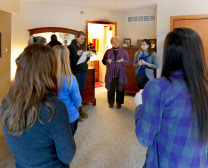
Northcrest CEO Linda Doyle gives Iowa State students a tour of the different housing options available. Photo by Bob Elbert (Larger photo)
“Especially in Iowa where we have a growing aging population, this is the future for design. If you look at design and design firms this is their focus,” Bates said. “It’s a great learning opportunity for students to learn about a specific demographic and their needs.”
Students offer a perspective that Linda Doyle, Northcrest CEO and administrator, appreciates. Several residents have a background in education and enjoy working with the students and professors, she said. Plus, Northcrest benefits from the research and ideas generated through class projects.
“It’s such an exhilarating experience,” Doyle said. “To have the opportunity to help students prepare for their careers as well as enhance the lives of residents who live here, it’s really a win-win situation. We see ideas that we haven’t thought of and see products that we didn’t know existed.”
Aging in place
Not everyone wants or can afford to move to a retirement community, and technology is one way older adults can continue living at home. Johnny Wong and Carl Chang, both professors of computer science, created the Smart Home Lab at Iowa State. They have consulted with Northcrest on monitoring systems that people can also use in their homes.
“We can use technology to monitor their wellness. They can use gaming systems to stay active,” Wong said. “We’re looking to develop non-invasive approaches to incorporating technology in the home.”
Wong and Chang say the field of gerontechnology focuses on how computers, sensors and other devices can assist with everyday activities and monitor safety for those who want to stay in their home. The next phase of Wong and Chang’s research involves brain wave analytics. Although it’s still in the initial stages, the two men are exploring how technology can determine if someone is happy, sad or depressed.
“This is very cutting edge,” Chang said. “This kind of research is still in its infancy, but it’s definitely the future. We hope to assess a person’s emotional state and help older adults overcome any kind of setback they may face.”
The ISU team expects the Northcrest partnership will lead to a variety of new research opportunities to improve the health and wellness of older adults. Sarah Francis, an assistant professor of food science and human nutrition, and Warren Franke, a professor of kinesiology, are currently working on an on-site wellness intervention to improve the activity and eating habits of Northcrest residents.
